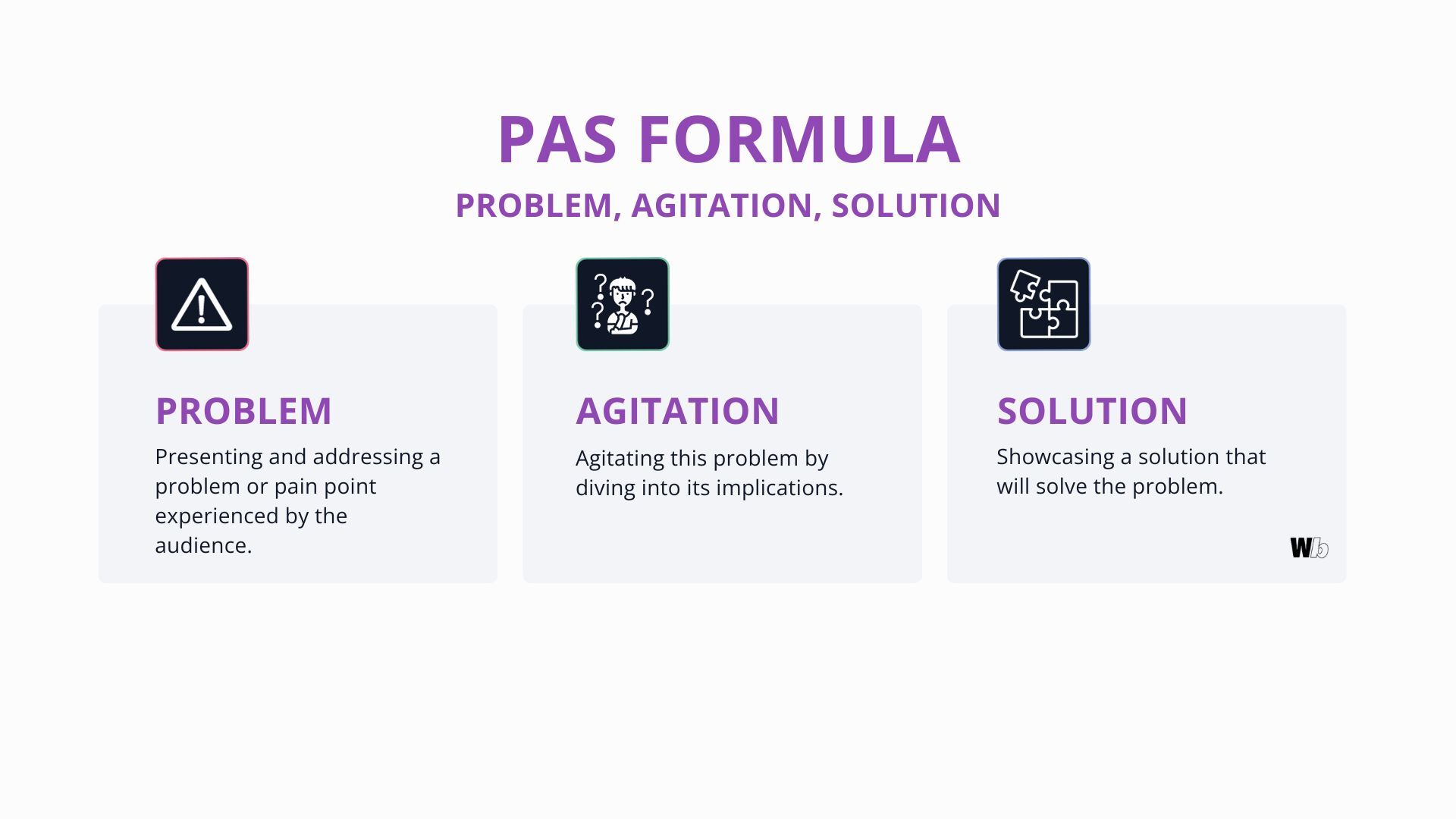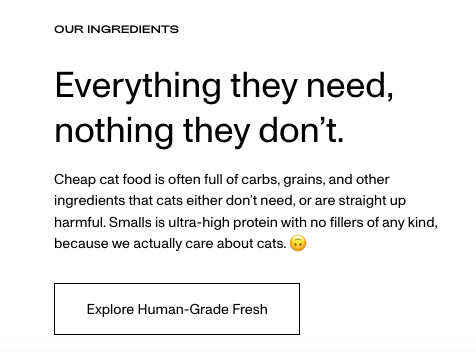Table of Contents
- Home
- »
- Content Marketing
- »
- How to use the PAS framework for B2B writing
-
Jack Ryder
- 8 minutes read time
How to use the PAS framework for B2B writing
- Home
- »
- Content Marketing
- »
- How to use the PAS framework for B2B writing
How to use the PAS framework for B2B writing
Table of Contents

In B2B content marketing, standing out can be a challenge. The PAS (Problem, Agitation, Solution) framework offers a structured approach to guide readers from recognizing challenges to embracing solutions. This strategic marketing can revolutionize your content’s impact and resonance. Whether you’re a seasoned writer or a newcomer, the PAS framework can be the linchpin of your content strategy.
By the end of this article, you’ll have seen a few examples of PAS in action and know how to make the PAS framework work for your business.
What is the PAS framework?
The PAS framework is a structured copywriting formula that stands for Problem, Agitation, Solution.
This impactful copywriting structure aligns with the decision-making process, seamlessly guiding a reader from problem recognition to considering a proposed solution.
There are three steps to the PAS writing formula that ensure good copywriting:

1. Presenting and addressing a problem or pain point experienced by the audience.
2. Agitating this problem by diving into its implications.
3. Showcasing a solution that will solve the problem.
According to the Content Marketing Institute, 73% of B2B marketers use content marketing, so implementing the PAS copywriting formula can set your content apart.
Content types you can use PAS for:
- Landing pages
- Blog posts
- PPC ads
- Social posts
- Video scripts
- And more!
Step 1: Understanding the problem
This first step of PAS is crucial, as it sets the stage for everything that follows. A well-articulated problem grabs attention and paves the way for introducing your solution later in the content. Below are steps and strategies to unearth and articulate problems effectively in your B2B content marketing and copywriting.
Often, the problem is presented as a question to get the reader thinking:

Source: Ticker Nerd website
But how do you find the right problem to tap into?
Conduct thorough research
Acknowledging your target audience’s problems and pain points is the top priority. This understanding is the first step in crafting content that strikes a chord.
Talking to and listening to your audience enables you to unlock insights you didn’t know. Rather than assuming you know your audience’s problems, you can conduct surveys or have one-on-one interactions that unveil their pain points. You’ll also get to hear the language customers use to describe them.
- Conduct 1-on-1 conversations with customers to get in-depth insights.
- Carry out market surveys to get a broad but high-level perspective.
Use online platforms
Nowadays, people go online to talk about everything, whether they’re leaving a review or posting their thoughts on social media.
Customer review sites often highlight common problems and can provide a wealth of information. The most beneficial review sites depend on your industry, but some good places to start are Google Reviews, TrustRadius, G2, and Capterra.
Also, discussion forums and social platforms are hotbeds for people to share their experiences and discuss their problems. By engaging in or observing these discussions, you can gather insights into common problems and pain points.
Analyze competitor offerings
Understanding how competitors position themselves can provide insights into the problems your target audience faces. While copying your competitors isn’t wise, they might have some details and experiences you don’t.
Firstly, analyzing the content your competitors produce can help identify the problems they are addressing. Be sure to look for recurring themes or issues that appear across different competitors’ content.
Dissect reviews of competitor products, looking for patterns in the complaints and issues users raise as well as the problems their product successfully solves.
Articulate the problem in the PAS copywriting framework
Once you have a clear understanding of the problems your audience faces, articulating them accurately becomes the cornerstone of your PAS copywriting. Here are three steps that help write copy that connects.
1. Use customer language: Write with the language and phrases your customers use to describe their problems. This shows you understand their issues.
2. Be specific and relatable: Describe the problem specifically, making it relatable to your audience. Avoid vague descriptions that might not resonate.
3. Include statistical evidence: If available, use data and statistics to quantify the problem. This validates the problem and provides a clearer picture of its impact.
Refine the problem statement over time
As markets evolve, the problems customers face change. Establish regular feedback loops with your sales and customer service teams to stay updated on the problems your customers are facing.
What’s more, don’t forget the importance of customer opinions. Be sure to consistently review customer interactions, like support tickets and sales calls. This will help to identify any new or evolving problems.
So, you’ve made readers feel like their problems are understood—the foundation for effective PAS copywriting is laid. Now, it’s time to agitate it before presenting how to solve the problem.
Step 2: Agitating readers
The agitation stage of the PAS copywriting framework is where readers are nudged from awareness of a problem to a state of eagerness for a resolution. This seeks to stir the emotional aspects of the identified problem, making readers more receptive to the forthcoming solution.
Smalls does this by telling the reader everything that’s wrong with cheap cat food.

Source: Smalls website
Use emotive language
The choice of words can significantly impact the reader’s engagement with the problem. Using emotive language helps to evoke a response that resonates on a personal level. The best ways to do this are:
- Incorporate words that strike a chord with readers to paint a vivid picture of the problem, making it relatable and urgent.
- Employ descriptive terms that encapsulate the frustrations or challenges tied to the problem. This helps in making the agitation authentic and compelling.
Address specific issues
Zeroing in on specific issues makes the agitation more tangible and less abstract. Breaking down the problem allows you to tap into the reader’s emotions and foster a deeper connection to the problem.
- Provide concrete examples of how the problem manifests in the reader’s world to stir a strong desire for a solution.
- Use real-world scenarios where the problem hampers progress or creates hurdles to underline the necessity of finding the perfect solution.
Relate the problem to the reader
Make the problem personal by relating it to challenges you uncovered with your research. This shows you truly understand your customers and makes the audience feel confident in your proposed solution.
- Highlight common industry challenges or shared experiences to help create a bond with the reader over the problem.
- Illustrate the impact of the problem on the reader’s day-to-day operations or long-term goals. This could encompass discussing the monetary, time, or resource costs associated with the problem.
Tackle misconceptions
Often, misconceptions or myths surround the problem. Addressing these can provide a clearer picture and intensify the desire for a solution.
- Debunk common myths that may prevent the reader from fully understanding the gravity of the problem. Doing so also positions your content as an informative and eye-opening read.
- Provide clarifications on common misunderstandings regarding the problem. This educative approach can further agitate the problem and drive home the need for a solution.
Discuss the costs of the problem
Discussing the costs associated with the reader’s problem can be a powerful agitation strategy. It presents a quantifiable measure of the problem’s impact and makes customers realize what they are currently sacrificing in return for a product or service that doesn’t solve their problems but causes them.
- Highlight any financial losses or extra expenses incurred due to the problem.
- Discuss the intangible costs like stress, loss of time, or missed opportunities that come with the problem.
An agitated problem requires a solution
By the end of the agitation section, the reader should have a well-rounded understanding of the problem but also feel a pressing need for a solution. When executed proficiently, the agitation phase prepares the reader for the introduction of the solution, making it a crucial bridge in the PAS formula. Through careful articulation and a reader-centric approach, the agitation phase can significantly enhance the effectiveness of your copywriting and set a solid groundwork for introducing your solution.
Step 3: Writing about the solution
Transitioning from agitation to solution is a delicate phase in the PAS copywriting framework. This isn’t the time to simply introduce your solution and hope it lands—it requires a considered approach to ensure a seamless transition and to hold the reader’s engagement.
Here’s an example of the PAS copywriting structure in full flow:

Source: Linkedin
Address past mistakes
Acknowledging past mistakes or common pitfalls associated with the problem creates a narrative of learning and improvement. It shows a deep understanding and an authentic approach toward finding the ideal solution. This tactic demonstrates a clear learning curve and how past mistakes have led to you improving your offering, showing your commitment to continuous improvement and evolution.
Showcase expected outcomes
Highlighting your solution’s expected outcomes provides a glimpse into a problem-free scenario that makes the solution desirable. Customers don’t really care about the product itself and who provides it—they’re concerned with solving their problems.
- Write benefit-driven copy that pulls out the benefits that come with your solution to show how it alleviates the identified problem. Features aren’t important. Instead, the benefits hit customers in the feels.
- Demonstrate the long-term value and positive changes your solution brings to the table, painting a picture of a favorable post-solution scenario. You’ve solved their problem, now what?
Highlight the uniqueness of your solution
Now’s the time to highlight the unique features of your solution that set it apart from others in the market.
Most industries are moving rapidly, so a unique feature today might not be unique tomorrow. Consumers want to know that you’re setting the pace in the industry and adopting an innovative approach. To demonstrate this, discuss how your solution tackles the problem and divulge your development plans for the future. This information showcases your distinct value proposition.
Illustrate the specifics of your solution
Once you’re this deep into the PAS copywriting framework, you should provide clear specifics of your solution to help readers understand exactly what you are offering.
Give the audience a detailed explanation of how your solution resolves the problem, discussing the features, capabilities, and processes involved. To cement your point, you should provide examples of real-world applications of your solution, illustrating its effectiveness in practical scenarios.
Build trust and deeper connections
Until now, you’ve established the foundation for trust with the PAS copywriting framework. Before a customer invests in your solution, they need to feel a deeper connection to your brand and product. This encourages them to consider your solution seriously. Here are two impactful ways to do this:
- Testimonials and case studies: Landing pages and web pages with social proof convert more than those that don’t.
- Educational content: Educational content helps readers understand the value and application of your solution better.
Pave the way for action
The solution stage should culminate in paving the way for the reader to take a specific action.
A clear call to action unmistakably shows the reader the next step and compels them to take it. Present accessible contact channels, whether a contact form, sign-up form, or phone number. The most important thing: Make sure the action is easy to take.
Give them the solution, and they will come
Crafting the solution stage with a clear focus, detailed explanation, and a reader-centric approach is pivotal in making the PAS framework effective. Addressing the reader’s concerns, showcasing the uniqueness of your solution, and providing clear paths to action create a conducive environment for engaging and converting your readers in the B2B space.
Final thoughts
PAS is a powerful copywriting framework for B2B writing and content marketing. It provides a structure to guide readers from pain point awareness to considering your solution. Understand and effectively implement each stage of this framework to write content that caters to your audience’s needs and concerns while building a compelling narrative that drives engagement and action.